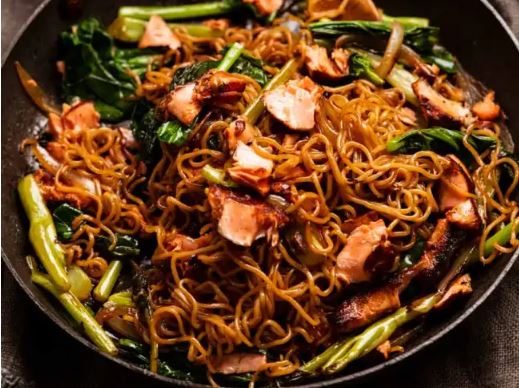Cooking with Sarah Boorer
Michael is joined by Sarah Boorer, Communications professional & CWA award-winning cook, to look at the world of baked goods, delicious treats and & easy recipes.
This week Sarah looks at Teriyaki Salmon Noodles. Recipe courtesy recipetineats.com
WHAT YOU NEED
- Salmon– Anywhere between 200 to 250g / 7 – 8oz salmon. Skinless is convenient, though if you can only get skin-on that’s fine too as the cooked flesh comes off the skin easily. You can use fillets, or cutlets with the bones removed.
- Noodles – I’ve used dried ramen noodles because it’s what I always have in stock in my pantry. While I actually prefer the flavour and texture of fresh noodles, I don’t always have them. Other dried noodles (yellow, white, rice noodles) and fresh noodles will work as well, see recipe notes for quantities.
- Chinese broccoli (gai lan / kai lan)– Probably my most used Asian vegetable, for sheer convenience (easy to chop) and also because I like the “broccoli” like texture of the stems. Substitute with any leafy Asian greens like choy sum, bok choy, pak choy, or about 2 1/2 cups of other vegetables sliced into stir fry-suitable sizes (eg. carrots and zucchini sliced on the diagonal).
- Onion and garlic– Essential flavour base ingredients I use for virtually every stir fry. Especially garlic!
TERIYAKI SAUCE
While I’ve been very up front about how this recipe is not a traditional Japanese dish (there is no such thing as teriyaki noodles in Japan!), the sauce ingredients are authentic.
- Soy sauce– All-purpose Japanese soy sauce. Please don’t use dark soy sauce, the flavour is far too intense and won’t work for this recipe! Sweet soy sauce is also unsuitable.
- Cooking sake and mirin – Two types of rice wines that are essential to Japanese cooking. No self-respecting Japanese restaurant or cook would ever call something “teriyaki” without using these!
Alcohol content note: The alcohol in cooking wine mostly evaporates when cooked, and the amount of wine used is small to begin with.
Sugar – Typically used in Teriyaki Sauce to make it a bit glossy and syrupy so it coats chicken nicely. In this recipe, it also helps the noodles caramelise, which adds flavour.
METHOD
- Teriyaki Sauce– Mix the ingredients in a bowl.
- Coat salmon in 1 tablespoon of the Teriyaki Sauce. No need to marinate – we’re cutting the salmon into thin-ish strips, which affords a good amount of salmon surface area for the Teriyaki Sauce to cover. The strips mean it also speeds up the cooking time. Win, win!
- Cook salmonfor just 1 1/2 minutes on each side until golden and just cooked through. The thin strips cook quickly! Once cooked, remove to a plate and set aside.
- Sauté aromatics– Give the pan a quick wipe (else we’ll end up with burnt teriyaki sauce throughout our noodles). Next we give the onion and garlic a head start before adding the Chinese broccoli stems. We won’t add the leafy part of the Chinese broccoli until towards the end as they take barely a minute to wilt.
- HALF the sauce – Add the noodles then just HALF the sauce. This allows the noodles to absorb the sauce faster so we can get nicer caramelisation on the noodles as they cook. If you add all the sauce at the same time, it takes almost double the time for the sauce to reduce.
- Toss the noodles until the sauce is absorbed and you no longer see any traces of it in the pan.
- Add remaining sauce then toss to disperse.
- Leave 30 seconds– Once the sauce is absorbed again, spread the noodles out and leave them undisturbed for 30 seconds. This encourages caramelisation of the noodles, compared to constantly tossing. Repeat this 3 to 4 times until you see the noodles get some nice colour on them.
- Extra oil + leaves – Add a bit of extra oil (again, for caramelisation encouragement!) then toss in the leafy part of the Chinese broccoli.
- Toss for another 1 minute or until the leaves wilt.
- Return salmon to the pan – Just tumble them on to the noodles along with any juices pooled on the plate.
- Serve! Break the salmon into large chunks, and briefly toss through the noodles. That’s it, we’re done. Time to eat. YAY!
Download this podcast here
















